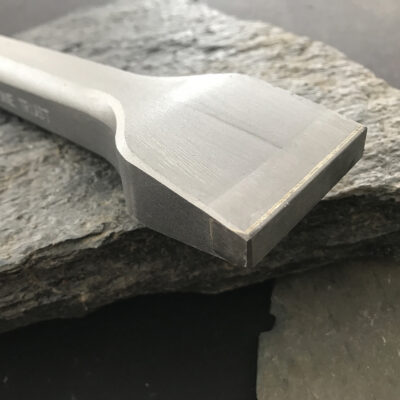Learning how to cut stone and shape rocks is an essential skill for any hardscaping professional. Mastery of these techniques can significantly elevate the quality of your work, reduce material waste, and minimize project costs. By acquiring these skills, you not only enhance the aesthetic appeal of your projects but also streamline your workflow, making your business more efficient and cost-effective. In this blog, we’ll review the basics of how to shape rocks for different hardscaping applications, a great precursor to live rock cutting demonstrations and workshops.
Rock Cutting Use Cases
When tackling a hardscaping project, the need to cut or shape stone can arise in several scenarios. Whether you’re splitting granite for a robust retaining wall, sculpting wall stone for a perfect fit, facing caps, fitting stacked stones in a fire pit, or trimming stone veneer for a facade, meticulous cuts are crucial. Haphazard cuts can quickly create uneven lines, remove too much material, and ultimately result in wasted stones that can’t be used. Honing your rock cutting skills ensures stability and durability as well as achieving the desired visual effect.
These skills also enable you to utilize materials that are already available on-site, such as natural stones in your client’s yard, allowing for a more authentic integration with the surrounding landscape. Being able to shape materials as needed also reduces excess purchases and material costs. Efficient use of stone means cleaner project sites and less environmental impact due to reduced waste.
2 Types of Rocks You’ll Work With
Understanding the material you’re working with is fundamental. Level bedded rocks, such as sandstone and limestone, typically offer a more uniform plane, making them easier to shape and cut. Irregular rocks, on the other hand, like fieldstone or certain granites, provide a more natural and rugged appearance but require a more skilled hand to manipulate. Knowing the characteristics of these rock types will guide you in choosing the right tools and techniques for your project.
Stone Cutting Tools You’ll Need
Power Tools
For efficient and precise rock cutting, several power tools are indispensable. Cut off saws and angle grinders, armed with diamond blades, are perfect for making straight cuts. Rotary drills are essential for boring holes or detailed shaping. Each tool has its purpose and, when used correctly, can significantly expedite the stone shaping process.
Hand Stone Cutting Tools
Traditional hand tools such as sledgehammers, wedges, feathers, and chisels are vital in the stone cutter’s arsenal. These stone cutting tools allow for more nuanced shaping and are perfect for smaller adjustments that require a human touch. They may be small, but they can pack a punch. Use hand tools to split or cut large rocks for a natural looking edge. You can choose either steel hand tools, which are a more economical option for light use and softer stone applications but require frequent sharpening, or carbide tipped tools which work on harder types of stone and last much longer than steel but are pricier. Always follow the manufacturer’s instructions for proper tool use and maintenance for best results and to prevent breakage – incorrect use can be a safety hazard in addition to voiding the warranty on an expensive tool.
Safety Equipment for Rock Cutting
Safety cannot be overstated when cutting stone. Always ensure you’re equipped with safety glasses, sturdy gloves, steel-toed boots, and respirators to protect against dust and debris if using power tools. These precautions are essential to prevent injuries and long-term health issues, allowing you to focus on the craft without worry.
6 Basic Types of Rock Cutting
Splitting: Breaking the stone into two parts with a clean line. Apply force to a wedge tipped hammer or chisel in the direction of the bedding plane or with the grain of the stone for the cleanest split.
High Spot Removal: Chipping away small areas to smooth or adjust the stone surface. Use a directional point to apply force at an angle to your high spot and avoid generating compression.
Dressing: Refining the stone to achieve a specific texture or shape. Done with lighter taps, use a directional point or chisel to crush the surface and make small chips to square your stone or make a decorative face.
Bending: Best for diminishing the size of large flat or long stones, bending is achieved by supporting the stone at either end and striking in the middle until it breaks.
Trimming: Removing excess material from the sides and edges to fit the stone into a certain space or design. Typically done perpendicular to the bedding plane or grain of the stone, use a mason chipper or trimming hammer to apply shearing force.
Tracing a Line: Cutting along a predetermined line for aesthetic or structural purposes. Lines can be drilled or chiseled and require consistent, slow pressure applied repeatedly along the line for a clean break.
How to Read Your Stone
Analyzing the stone’s natural characteristics is a critical skill. Detecting the bedding plane and grain direction, as well as existing cracks or imperfections, can inform where and how to make your cuts. Properly angling your tools and considering the size, weight, and type of rock will influence your approach to cutting, ensuring better results and fewer mistakes. For example, in spot removal, avoid angling your chisel directly down on a high point as it compresses the stone and makes chipping more difficult.
Patience: The Key to Rock Cutting
The most successful stone shaping is often achieved through light, even taps rather than forceful blows. This technique allows for more control and can help avoid unwanted fractures. Developing these skills takes time, but the precision and quality they bring to your work are invaluable.
With patience and practice, your offerings to clients will expand, and the value of your work will increase. Explore Genest’s wide selection of natural stone online or visit us at one of our three retail centers to begin envisioning how your rock cutting skills can be put to use at your next jobsite. Want a more in-depth introduction to cutting stone veneer, shaping wall stone, rock-facing bluestone, and more? Join us February 6th or 8th for an Intro to Shaping Stone with industry experts, Trow & Holden Company. These resources are designed to help grow your business and refine your craftsmanship in stone hardscaping.




